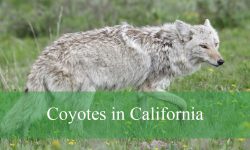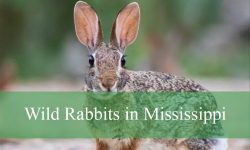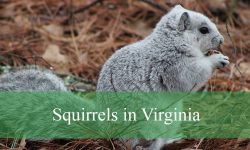New Hampshire’s forests, wetlands, and open meadows are home to an impressive variety of owl species. From the haunting call of the Barred Owl echoing through woodlands to the ghostly flight of a Snowy Owl over a frozen marsh, these nocturnal hunters add mystery and beauty to the Granite State’s wild landscape.
In this guide, you’ll learn about the 11 types of owls found in New Hampshire, how to identify them, where they live, and the best times to see or hear them in the wild. Whether you’re an avid birder, nature photographer, or casual observer, understanding these owls will make your nights in the forest far more exciting.
Overview of Owls in New Hampshire
Owls in New Hampshire can be divided into resident species that live year-round and migratory visitors that appear during certain seasons.
Most are active at night, hunting rodents, insects, or small birds. However, some, like the Northern Hawk Owl or Short-eared Owl, may also hunt in daylight.
These 11 species vary greatly in size, habitat preference, and vocalization — from the tiny Northern Saw-whet Owl to the majestic Great Horned Owl. Let’s explore each one in detail.
Types of Owls Found in New Hampshire
Barred Owl (Strix varia)
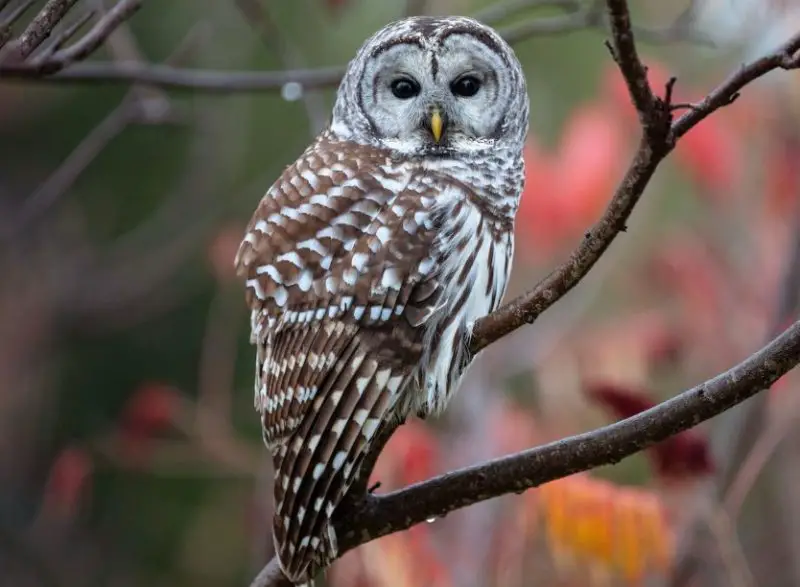
The Barred Owl is one of the most easily recognized owl species in New Hampshire, famous for its deep, resonant call that sounds like “Who cooks for you? Who cooks for you all?” This haunting hoot often carries through the night woods and along quiet river valleys, signaling the owl’s presence even when it remains hidden in dense branches. Its calm, watchful demeanor and distinctive voice make it a favorite among birdwatchers and nature enthusiasts.
Physically, the Barred Owl stands out with its rounded head that lacks ear tufts, large dark brown eyes, and a beautifully patterned body marked with vertical brown-and-white barring on the chest and horizontal barring on the belly. These patterns help it blend seamlessly into tree trunks, offering excellent camouflage during daylight hours. Adults measure about 16–25 inches long, with a wingspan reaching up to 44 inches, making them moderately large compared to other local owl species.
Their preferred habitats are mature deciduous or mixed forests with a high canopy, often near swamps, streams, or wooded river corridors. They thrive in the quiet, damp woodlands of southern and central New Hampshire, where old-growth trees provide nesting cavities. Barred Owls typically nest in natural tree hollows, old hawk nests, or abandoned squirrel dens, and both parents share in raising their young.
Barred Owls are permanent residents of New Hampshire, remaining active throughout the year regardless of season. During the day, they may be spotted quietly roosting in the shadows of tall trees. Known for their curiosity, these owls occasionally approach human activity out of interest rather than fear. Their diet consists mainly of small mammals, birds, frogs, and even crayfish, making them efficient nighttime hunters and valuable members of New Hampshire’s forest ecosystem.
Great Horned Owl (Bubo virginianus)
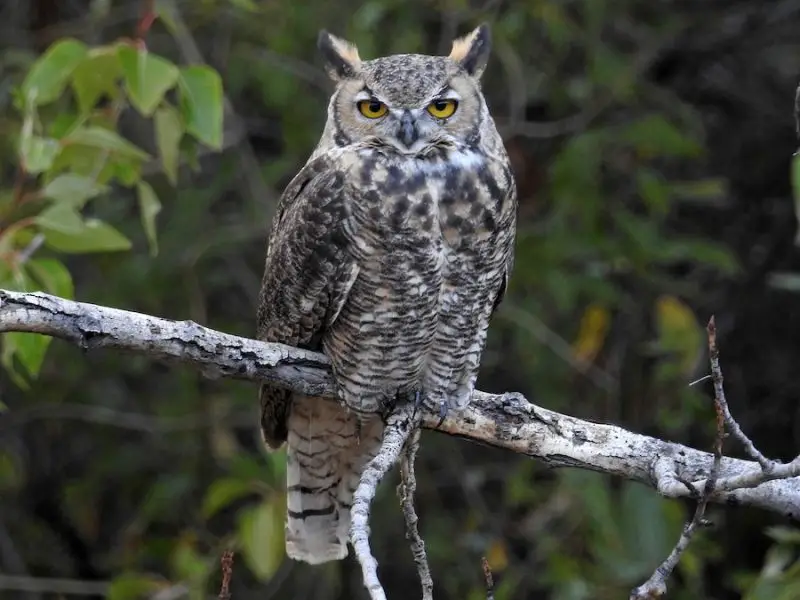
The Great Horned Owl, often called the “tiger of the sky,” is one of the most formidable and widespread owl species in New Hampshire. Its deep hooting call — a rhythmic “hoo-hoo-hoo-hoo” — is one of the most familiar sounds of the forest at night. With its fierce expression, broad wings, and silent flight, the Great Horned Owl commands respect as a top predator in the state’s nocturnal ecosystem.
This large owl is instantly recognizable by its prominent ear tufts, intense yellow eyes, and mottled gray-brown plumage that helps it blend into tree bark. Its thick feathering provides insulation during New Hampshire’s cold winters, allowing it to remain active even in freezing temperatures. Adults typically measure between 18 to 25 inches long, with a wingspan stretching up to five feet.
Highly adaptable, the Great Horned Owl inhabits forests, woodlots, farmlands, and even suburban parks. It can thrive anywhere with sufficient prey and a few tall trees for nesting. Instead of building its own nest, this owl often reuses old hawk or crow nests, cliff ledges, or tree cavities. It is the earliest nesting owl in New Hampshire, with eggs often laid in late January or February — well before the snow melts.
As an apex nocturnal predator, the Great Horned Owl’s diet is incredibly diverse. It hunts skunks, rabbits, squirrels, waterfowl, and even other raptors, using its powerful talons to crush prey instantly. Its adaptability and dominance make it one of New Hampshire’s most successful and enduring owl species, found throughout the state year-round.
Eastern Screech-Owl (Megascops asio)
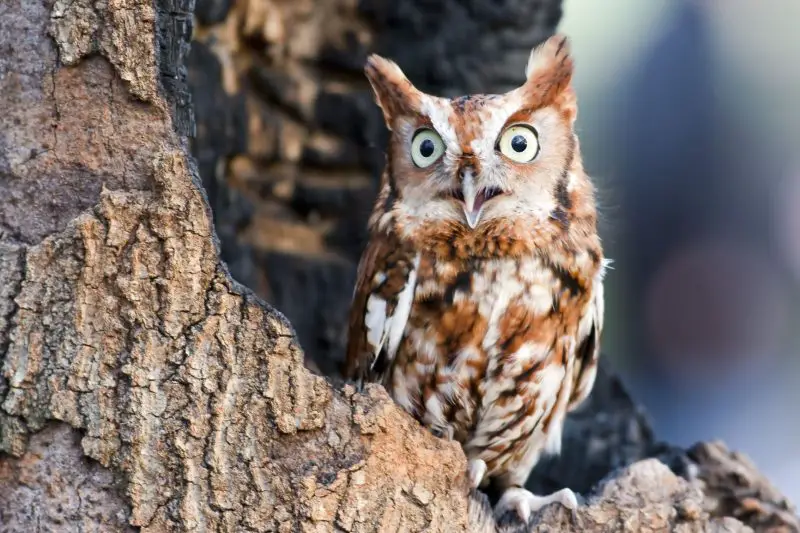
The Eastern Screech-Owl is a small yet spirited bird that thrives in southern and central New Hampshire. It’s a master of camouflage, blending so perfectly with tree bark that it can be nearly impossible to spot when roosting. Despite its name, it doesn’t “screech” — instead, it produces a gentle trilling or descending whinny that echoes softly through wooded neighborhoods and farmlands.
This owl comes in two color morphs, gray and reddish-brown, both patterned with streaks and spots that mimic the texture of tree bark. It has small ear tufts, bright yellow eyes, and a compact body about 8 to 9 inches long, making it one of the smallest owls in the region. The species’ adaptability allows it to survive in diverse environments, from orchards and forests to suburban backyards.
Eastern Screech-Owls nest in tree cavities, abandoned woodpecker holes, or nest boxes, often staying close to water sources or open fields for easy hunting. They’re not migratory and can be found throughout the year in New Hampshire, even during snowy months. Their ability to remain motionless and silent during the day helps them avoid predators while resting.
Though tiny, Screech-Owls are skilled hunters. Their diet includes mice, small birds, insects, frogs, and even small fish. They play a crucial role in natural pest control, making them a welcome guest in rural and suburban areas. Providing nest boxes or preserving old trees can attract these charming owls to your property.
Northern Saw-whet Owl (Aegolius acadicus)
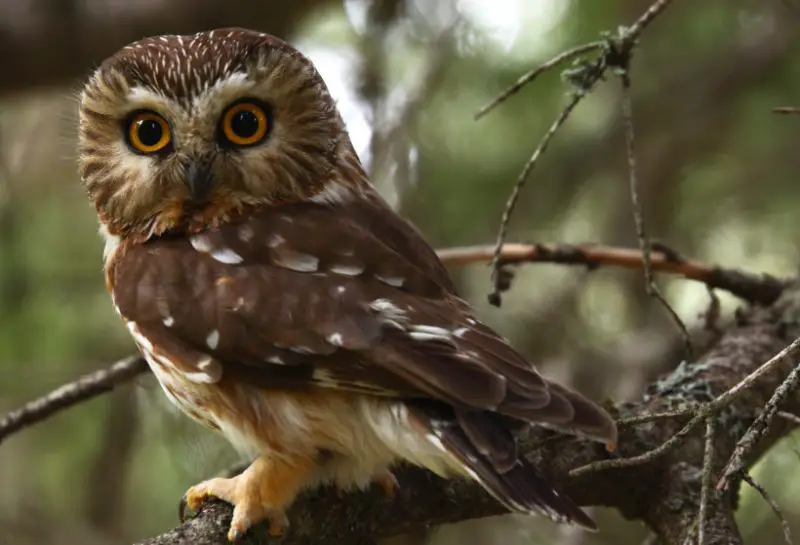
The Northern Saw-whet Owl is a miniature marvel among New Hampshire’s owls, rarely standing more than eight inches tall. Despite its size, it has a fierce personality and is an efficient hunter of small rodents. Its round head lacks ear tufts, and its large golden-yellow eyes give it an innocent, doll-like appearance. The bird’s name comes from one of its calls — a repetitive “too-too-too” sound that some say resembles a saw being sharpened on a whetstone.
Saw-whet Owls prefer dense coniferous and mixed forests, where their streaked brown plumage helps them stay hidden during the day. They roost quietly in evergreens or thickets and become active at dusk, using their acute hearing to locate prey beneath leaves or snow. Because of their secretive nature, they’re often detected by sound rather than sight.
These owls are year-round residents in northern and central New Hampshire, though some migrate southward in winter depending on food availability. They are most commonly encountered during migration seasons, especially in late fall, when they travel through wooded areas and can sometimes be found resting near trails or forest edges.
The Northern Saw-whet Owl primarily feeds on mice, voles, and small birds, occasionally adding insects to its diet. Despite being one of the smallest owls in North America, it’s a skilled predator with precise flight control and an uncanny ability to hunt silently. Spotting one in the wild is a rare and delightful reward for patient birdwatchers.
Snowy Owl (Bubo scandiacus)
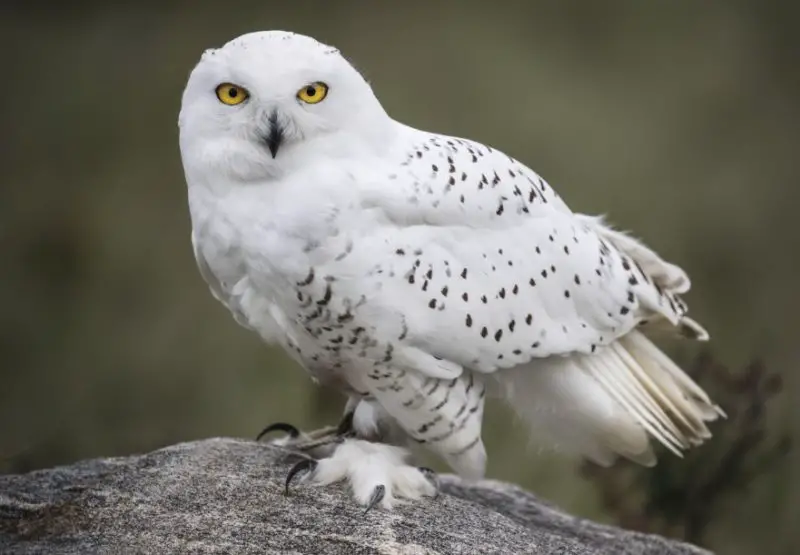
The magnificent Snowy Owl is one of the most awe-inspiring winter visitors to New Hampshire. Originating from the Arctic tundra, these striking white owls migrate southward every few years when food, particularly lemmings, becomes scarce in their native range. Their arrival in New England’s cold months is always an event, drawing birdwatchers eager to glimpse their bright white plumage dotted with black or gray markings. Males tend to be nearly pure white, while females and younger owls display heavier dark barring for camouflage.
Unlike most other owls, the Snowy Owl is diurnal, meaning it is active during the day. It prefers wide-open spaces that mimic its tundra home, such as coastal dunes, airport fields, shorelines, and expansive farmlands. These habitats provide the open visibility and hunting conditions it relies on to spot small mammals and birds from afar.
In New Hampshire, Snowy Owls are rare but regular winter visitors, typically arriving between late November and March. Their appearance is unpredictable, often linked to “irruption years,” when large numbers migrate south due to population booms or food shortages in the Arctic. During these times, they may be spotted perched on fence posts, snowbanks, or even airport runways.
Their regal appearance and calm demeanor make them favorites among photographers and nature enthusiasts. Watching a Snowy Owl silently scan a snowy field in the golden light of dawn is one of the most magical experiences a New England winter can offer.
Barn Owl (Tyto alba)
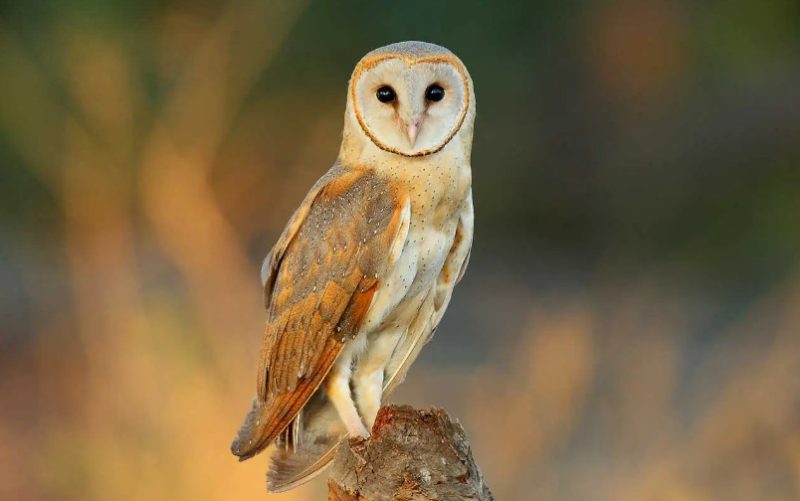
The Barn Owl is a rare and localized species in New Hampshire, most frequently seen in the southern part of the state. Known for its ghostly flight and eerie calls, it is easily recognized by its distinctive heart-shaped white face, long slender wings, and pale golden plumage. Its silent flight and haunting screech contribute to the myths and legends surrounding owls for centuries.
Unlike most owl species that rely on sight to hunt, Barn Owls depend heavily on exceptional hearing, which allows them to detect prey even in total darkness. They glide silently over open fields, meadows, and farmlands, capturing voles, mice, and other small mammals. Their heart-shaped facial disc funnels sound directly to their ears, making them among the most efficient nighttime hunters.
In New Hampshire, Barn Owls prefer to roost and nest in old barns, silos, church steeples, or large nest boxes. However, because they are sensitive to prolonged cold, their presence is limited. Occasionally, a few individuals are recorded during mild winters, especially in areas near the Massachusetts border.
Conservation efforts that preserve open farmlands and provide safe nesting spaces are vital for supporting Barn Owl populations in the region. With adequate shelter and milder conditions, these ethereal birds could become a more consistent part of New Hampshire’s avian landscape.
Short-eared Owl (Asio flammeus)
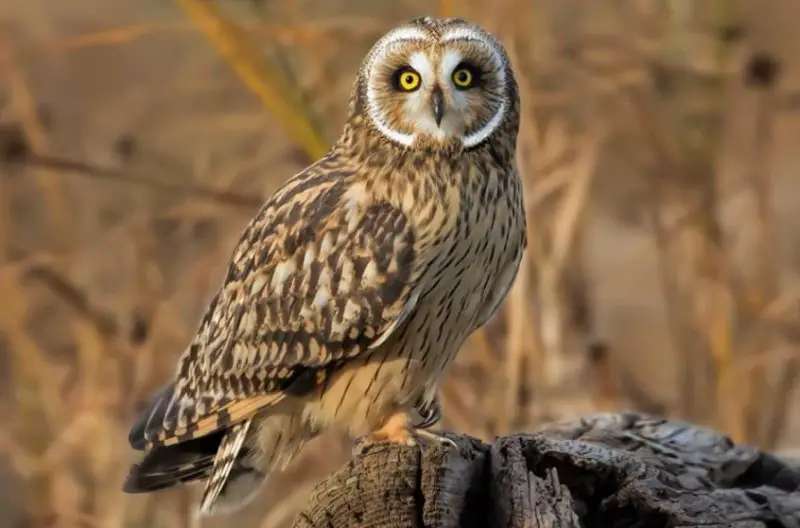
The Short-eared Owl is a striking species known for its daytime hunting behavior and graceful, buoyant flight over meadows and marshes. It has mottled buff and brown plumage, pale underparts, and short, inconspicuous ear tufts that give it its name. Its round facial disk and yellow eyes convey a look of constant alertness.
These owls are highly migratory, spending summers breeding in northern regions and returning to open areas of New Hampshire during the winter months. They frequent grasslands, marshes, fields, and coastal plains, particularly along the state’s southern and seacoast regions. Their presence peaks between November and April, when they can be seen flying low over fields, scanning for rodents with a buoyant, moth-like motion.
Short-eared Owls are one of the few owls that regularly hunt during daylight hours, especially at dawn and dusk. Their calls are distinctive — a series of barks and hoots — and their aerial displays during courtship are an impressive sight, involving dives, wing claps, and looping flights.
Although populations have declined due to the loss of open grassland habitats, they remain regular winter visitors in New Hampshire. Observing a Short-eared Owl gliding silently over a frosty meadow at sunset is an unforgettable experience for any bird lover.
Long-eared Owl (Asio otus)
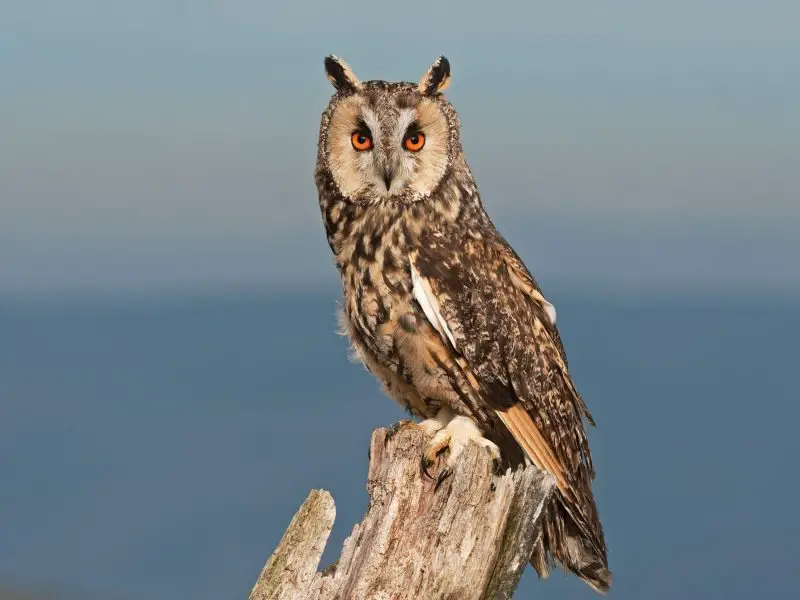
The Long-eared Owl is among the most secretive and well-camouflaged owl species in New Hampshire. Slender and elegant, it is named for its prominent ear tufts that stand upright when the bird feels alert or threatened. With its orange facial discs, streaky brown plumage, and piercing yellow eyes, it blends perfectly into conifer branches, making it difficult to detect even at close range.
This nocturnal owl prefers dense coniferous or mixed forests located near open meadows or fields, where it can hunt small mammals. It often roosts communally in winter, using thick evergreens for protection from the cold and from predators. Despite its secrecy, the Long-eared Owl’s deep “hoo-hoo” call sometimes betrays its presence in quiet forested areas at night.
In New Hampshire, Long-eared Owls are uncommon winter visitors, though a few may breed in the northern parts of the state. They often use abandoned crow or hawk nests rather than building their own. During migration, they may also appear in sheltered groves near open country, resting quietly during the day.
Because they rely on both forest cover and open hunting grounds, habitat conservation is crucial to maintaining Long-eared Owl populations. For those lucky enough to find one, witnessing this mysterious bird perched silently among evergreens is a truly remarkable sight.
Boreal Owl (Aegolius funereus)
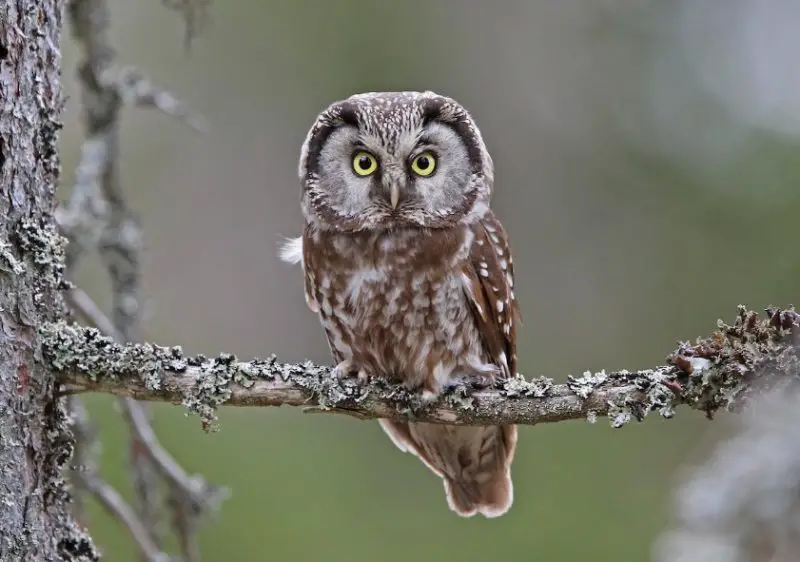
The Boreal Owl is one of the most elusive and mysterious owl species found in New Hampshire. This small owl inhabits the cold, dense coniferous forests of the state’s northernmost regions, where spruce and fir trees dominate the landscape. Its compact body, large square-shaped head, and vivid yellow eyes give it a striking appearance despite its tiny size. Adults measure only about 9 to 10 inches long, making them similar in size to the Northern Saw-whet Owl but slightly bulkier.
These owls are primarily nocturnal and extremely quiet, which makes them difficult to spot even in areas where they are present. They prefer remote habitats with minimal human disturbance and are most active on clear, still nights. During winter, however, a few Boreal Owls may venture south into lower elevations in search of food, offering patient and lucky birders the rare chance to observe them.
Their diet consists mainly of small rodents, such as voles and mice, supplemented occasionally by small birds or insects. They hunt from low perches, swooping silently down to catch prey on the forest floor. Their calls are soft, rhythmic hoots — a gentle “poo-poo-poo” sound that can sometimes be heard echoing through the stillness of a snowy forest night.
In New Hampshire, Boreal Owls are considered rare residents, primarily confined to the northern regions and high-elevation forests. Because of their preference for isolated, boreal habitats, little is known about their breeding behavior in the state. Finding one requires persistence, timing, and a bit of luck — a rewarding challenge for serious bird enthusiasts.
Great Gray Owl (Strix nebulosa)
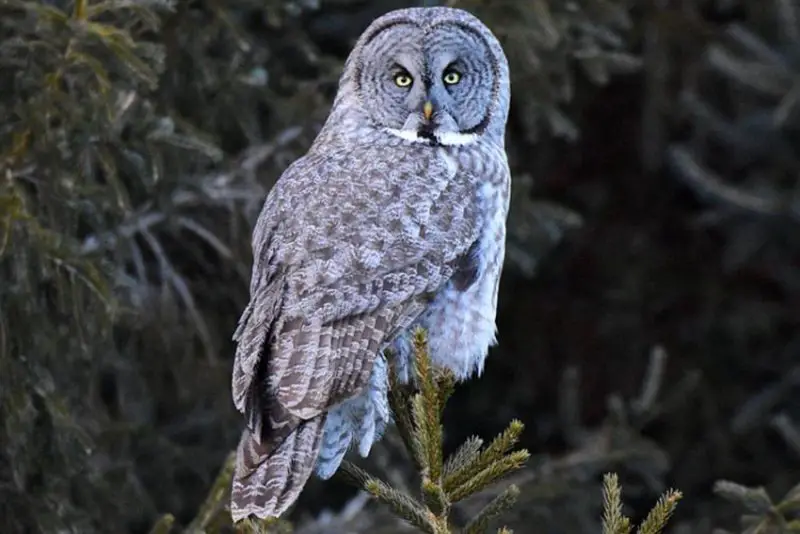
The Great Gray Owl is the largest owl species in North America by length, often measuring over 30 inches tall with a wingspan exceeding four and a half feet. Despite its massive appearance, it is surprisingly lightweight due to its fluffy feathers and slender frame. Covered in soft, gray plumage streaked with white and brown, and adorned with a broad facial disc and piercing yellow eyes, this owl embodies silent majesty.
This species is a rare winter visitor to New Hampshire, typically appearing only during years when food becomes scarce in its primary range across Canada. When vole populations crash in the boreal forests of the north, Great Gray Owls may wander southward into northern New England, seeking open meadows and forest edges where they can hunt.
Unlike many owls that rely primarily on sight, Great Gray Owls depend heavily on their extraordinary hearing to locate prey beneath deep snow. They can detect and strike rodents hiding under several inches of snow with remarkable accuracy. Their favored habitats are boreal forests, bog edges, and open fields, where they perch silently, scanning for movement.
Though intimidating in size, these owls are known for their gentle and quiet temperament. They rarely vocalize outside the breeding season, and their deep, resonant hoots are seldom heard in New Hampshire. Spotting one perched against a snowy backdrop is a once-in-a-lifetime experience for birdwatchers in the Granite State.
Northern Hawk Owl (Surnia ulula)
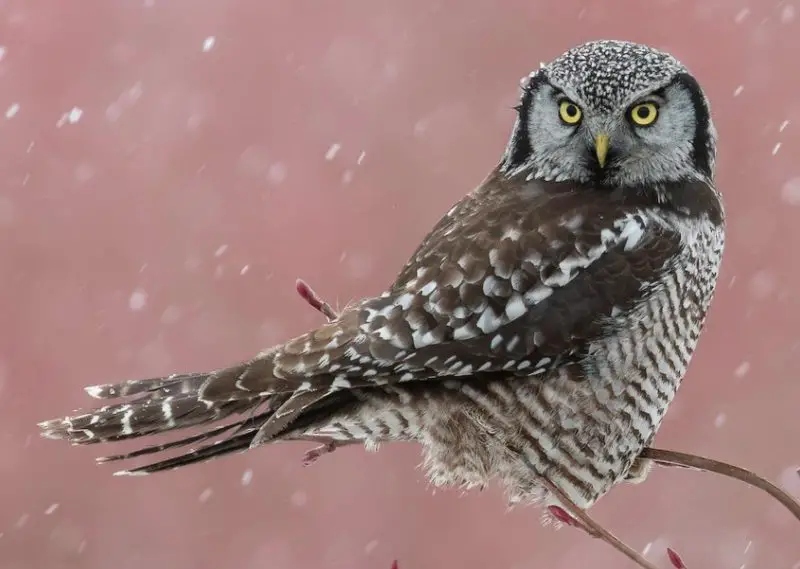
The Northern Hawk Owl is one of the most distinctive and fascinating owls that occasionally visit New Hampshire. As its name suggests, it behaves more like a hawk than a typical owl — active during the day and relying primarily on sharp vision to locate prey rather than sound. This diurnal behavior sets it apart from most other owl species found in the region.
It is easily recognized by its long tail, rounded head without ear tufts, and striking brown-and-white barred plumage across the chest. Its sharp facial markings, yellow eyes, and upright posture give it an alert, predatory appearance. Typically, Northern Hawk Owls are about 14 to 17 inches long, placing them between the size of a Screech-Owl and a Great Horned Owl.
In winter, this species occasionally wanders south from the Arctic and subarctic regions into northern New Hampshire, particularly after population surges or prey shortages in Canada. They prefer open woodlands, farmlands, and forest edges where they can perch on treetops, telephone poles, or fence posts to watch for small mammals.
Although sightings are rare, those fortunate enough to encounter a Northern Hawk Owl will likely see it perched conspicuously and hunting boldly in daylight. Their fearless nature and willingness to remain visible make them a thrilling sight for photographers and birders alike. When one appears, it often becomes a regional highlight, drawing birdwatchers from across New England.
Identification Tips: How to Recognize Owls in New Hampshire
Owls can be tricky to identify, especially in low light. Here are some clues to help you:
-
Size and silhouette: Great Horned Owls are bulky with large ear tufts, while Saw-whet and Boreal Owls are small and round-headed.
-
Eyes: Barred Owls have dark brown eyes, whereas most others have bright yellow eyes.
-
Call: Each species has a distinctive vocal pattern — from the Barred Owl’s “Who cooks for you?” to the Saw-whet’s repetitive whistle.
-
Habitat: Different owls prefer specific environments — Snowy Owls in open tundra-like areas, Screech-Owls in wooded suburbs, etc.
Best Places to See Owls in New Hampshire
If you want to observe owls in the wild, visit these top locations:
-
White Mountain National Forest: Excellent for Boreal and Barred Owls.
-
Great Bay National Wildlife Refuge: Great for Short-eared and Snowy Owls in winter.
-
Merrimack River floodplain forests: Good for Barred and Great Horned Owls.
-
Local parks and cemeteries: Screech-Owls often nest near human habitation.
Be sure to bring binoculars and avoid using flashlights directly on owls, as it can disturb them.
Owl Calls in New Hampshire
Learning owl calls can greatly increase your success rate. Here are a few to memorize:
-
Barred Owl: “Who cooks for you? Who cooks for you all?”
-
Great Horned Owl: Deep series of hoots — “hoo-hoo-hoo-hoo.”
-
Screech-Owl: A descending whinny sound.
-
Saw-whet Owl: Rapid “too-too-too” notes.
Listening quietly during calm nights in early spring or late fall gives you the best chance to hear them.
Conservation and Legal Protection
All owls in New Hampshire are protected by state and federal law, including the Migratory Bird Treaty Act. It’s illegal to harm, capture, or disturb their nests.
Habitat preservation is crucial, especially for species like the Barn Owl and Boreal Owl that are sensitive to environmental change. Supporting forest conservation and sustainable land use helps ensure these magnificent raptors remain part of New Hampshire’s ecosystem.
Frequently Asked Questions (FAQs)
What is the most common owl in New Hampshire?
The Barred Owl and Great Horned Owl are the most common and widespread owls in New Hampshire. They live in forests across the state year-round.
Are there Snowy Owls in New Hampshire?
Yes. Snowy Owls occasionally appear during the winter, especially along the seacoast and large open fields. Their presence varies each year depending on prey availability in the Arctic.
What owl makes a “who cooks for you” call?
That famous call belongs to the Barred Owl, one of the most vocal and recognizable owls in New England.
Do owls migrate from New Hampshire?
Some species, like the Short-eared Owl and Northern Saw-whet Owl, migrate seasonally, while others remain year-round residents.
Can I attract owls to my yard?
Yes, you can. By installing nest boxes (for Screech-Owls or Saw-whets) and keeping your yard natural with minimal light pollution, you may invite these birds to visit.
Conclusion
New Hampshire’s mix of forests, wetlands, and farmlands creates the perfect home for a diverse range of owls — from the powerful Great Horned Owl to the delicate Northern Saw-whet Owl. Some, like the Barred and Screech-Owls, are regular neighbors, while others, like the Snowy or Great Gray Owls, visit only during the coldest months.
Whether you’re listening to eerie hoots on a quiet night or spotting white wings over snow-covered fields, encountering an owl in New Hampshire is always a magical experience. With patience and respect for wildlife, these mysterious birds will continue to thrive in the Granite State’s wild and peaceful landscapes.

